Monitoring Desertification Using a Small Set of Biophysical Indicators in the Brazilian Semiarid Region
Abstract
1. Introduction
2. Materials and Methods
2.1. Contextualization and Characteristics of the Studied Area
2.2. Methodological Procedures
2.2.1. Step 1—Pilot Site Selection
2.2.2. Step 2—Biophysical Indicators’ Quantification and Analysis
2.2.3. Step 3—Biophysical Indicator Selection
2.2.4. Step 4—Selection of the Desertification Indicators
3. Results
3.1. Paired t-Test between Pilot Sites and Biophysical Indicators
3.2. Pearson Correlation between the Biophysical Indicators of the Pilot Sites
3.3. Principal Component Analysis of the Minimum Set of Biophysical Attributes of the Pilot Sites
4. Discussion
5. Conclusions
Author Contributions
Funding
Institutional Review Board Statement
Informed Consent Statement
Data Availability Statement
Acknowledgments
Conflicts of Interest
Appendix A
| Desertified Area | Year | ||
|---|---|---|---|
| 1999/2000 | 2009/2010 | 2015 | |
| 1 |  |  | 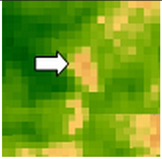 |
| 2 |  | 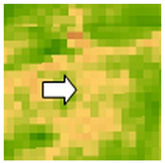 |  |
| 3 |  | 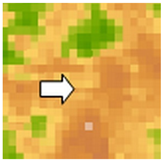 |  |
| 4 | 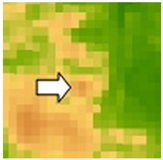 |  | 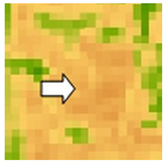 |
| 5 |  |  |  |
| 6 | 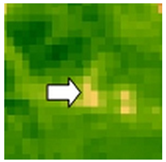 |  | 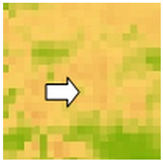 |
| 7 |  | 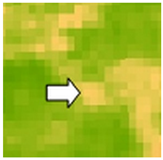 | 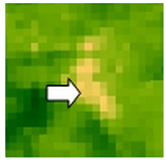 |
| 8 |  | 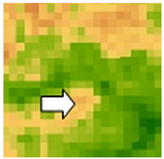 |  |
| 9 | 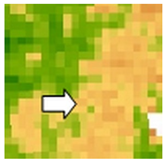 | 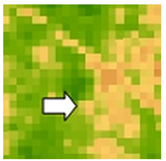 |  |
| 10 |  |  |  |
| 11 |  | 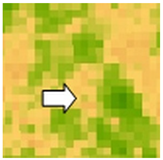 | 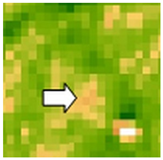 |
| 12 | 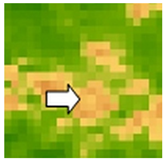 | 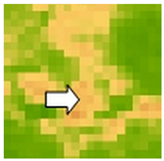 |  |
| 13 |  |  |  |
| 14 |  |  | 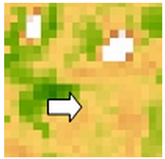 |
| 15 | 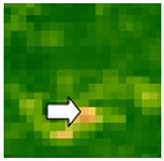 | 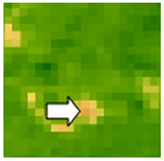 |  |
| 16 | 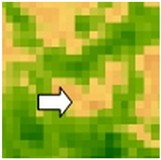 |  | 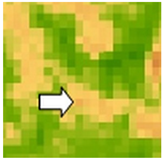 |
| 17 | 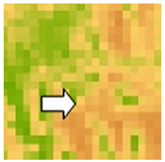 | 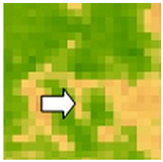 | 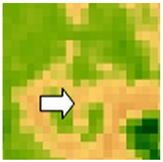 |
| 18 | 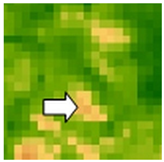 |  | 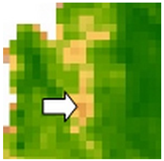 |
| 19 | 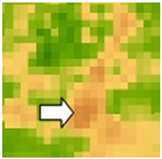 | 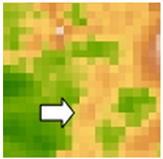 |  |
| 20 |  | 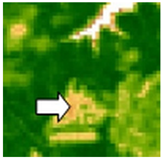 | 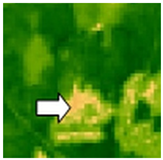 |
| 21 |  | 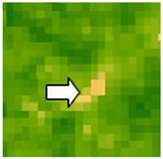 | 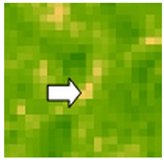 |
| 22 |  |  |  |
 | |||
References
- UNCCD—United Nations Convention to Combat Desertification. Convention to Combat Desertification in Countries Experiencing Serious Drought and/or Desertification, Particularly in Africa; ONU: Paris, France, 1994; 56p. [Google Scholar]
- UNEP—United Nations Environment Programme. World Atlas of Desertification, 2nd ed.; UNEP: London, UK, 1997; 182p. [Google Scholar]
- Pimm, S.L. The World According to Pimm: A Scientist Audits the Earth; McGraw-Hill: Chicago, IL, USA, 2001; 287p. [Google Scholar]
- Dobie, P. The Global Drylands Partnership; UNDP: Nairobi, Kenya, 2011; 491p. [Google Scholar]
- Pérez-Marin, A.M.; Cavalcante, A.M.; Medeiros, S.S.; Tinôco, L.B.; Salcedo, I.H. Núcleos de desertificação no semiárido brasileiro: Ocorrência natural ou antrópica? Parcer. Estratégica 2012, 17, 87–106. [Google Scholar]
- Fernandes, M.M.; Fernandes, M.R.M.; Garcia, J.R.; Matricardi, E.A.T.; Lima, A.H.S.; Filho, R.N.A.; Filho, R.R.G.; Piscoya, V.C.; Piscoya, T.O.F.; Filho, M.C. Land use and land cover changes and carbon stock valuation in the São Francisco river basin, Brazil. Environ. Chall. 2021, 5, 100247. [Google Scholar] [CrossRef]
- De Oliveria, M.L.; Dos Santos, C.A.C.; De Oliveira, G.; Perez-Marin, A.M.; Santos, C.A.G. Effects of human-induced land degradation on water and carbon fluxes in two different Brazilian dryland soil covers. Sci. Total Environ. 2021, 792, 148458. [Google Scholar] [CrossRef]
- Barbosa Neto, M.V.; de Araújo, M.S.B.; de Araújo Filho, J.C.; Sampaio, E.V.S.B.; Almeida, B.G. Rill and sheet soil erosion estimation in an area undergoing desertification in the Brazilian semi-arid region. Model. Earth Syst. Environ. 2021, 7, 1183–1191. [Google Scholar] [CrossRef]
- Accioly, L.J.O.; Silva, E.A.; Cavalcanti, E.A.; Alves, E.S.; Pereira, A.G.S.; Silva, R.S.; Ramos, R.R.D.; Silva, R.R. Mapeamento Do Uso e Cobertura Das Terras Do Semiarido Pernambucano (Escala 1:100.000); Embrapa: Rio de Janeiro, Brazil, 2017; Available online: https://www.embrapa.br/busca-de-publicacoes/-/publicacao/1079144/mapeamento-do-uso-e-cobertura-das-terras-do-semiarido-pernambucano-escala-1100000 (accessed on 15 April 2022).
- Sampaio, E.V.; Sampaio, Y.; Vital, T.; Araújo, S.B.; Sampaio, G.R. Desertificação no Brasil: Conceitos, Núcleos e Tecnologias de Recuperação e Convivência; Universitária da UFPE: Recife, Brazil, 2003; 202p. [Google Scholar]
- Antongiovanni, M.; Venticinque, E.M.; Matsumoto, M.; Fonseca, C.R. Chronic anthropogenic disturbance on Caatinga dry forest fragments. J. Appl. Ecol. 2020, 57, 2064–2074. [Google Scholar] [CrossRef]
- Crispim, A.B.; Melo, C.C.F.; Almeida, I.C.S.; Oliveira, L.S. Bases introdutórias sobre degradação ambiental no semiárido brasileiro. In 3° Seminário Regional Norte e Nordeste de Pós-Graduação em Geografia; UFPB: João Pessoa, Brazil, 2013; Available online: http://www.geociencias.ufpb.br/posgrad/sernne/artigo16.pdf (accessed on 2 May 2022).
- Yang, Z.; Zhang, Q.; Hao, X.; Yue, P. Changes in evapotranspiration over global semiarid regions 1984–2013. J. Geophys. Res. Atmos. 2019, 124, 2946–2963. [Google Scholar] [CrossRef]
- Mariano, D.A.; dos Santos, C.A.C.; Wardlow, B.D.; Anderson, M.C.; Schiltmeyer, A.V.; Tadesse, T.; Svoboda, M.D. Use of remote sensing indicators to assess the effects of drought and human-induced land degradation on ecosystem health in Northeastern Brazil. Remote Sens. Environ. 2018, 213, 129–143. [Google Scholar] [CrossRef]
- Althoff, T.D.; Menezes, R.S.C.; de Carvalho, A.L.; de Siqueira Pinto, A.; Santiago, G.A.C.F.; Ometto, J.P.H.B.; von Randow, C.; Sampaio, E.V.D.S.B. Climate change impacts on the sustainability of the firewood harvest and vegetation and soil carbon stocks in a tropical dry forest in Santa Teresinha Municipality, Northeast Brazil. Forest Ecol. Manag. 2016, 360, 367–375. [Google Scholar] [CrossRef]
- Santana, M.S.; Andrade, E.M.; Sampaio, E.V.S.B.; Tiago, O.F.; Salviano, A.M.; Silva, D.J.; Cunha, T.J.F.; Giongo, V. Do agrosystems change soil carbon and nutrient stocks in a semiarid environment? J. Arid. Environ. 2022, 201, 104747. [Google Scholar] [CrossRef]
- Menezes, R.S.C.; Sales, A.T.; Primo, D.C.; Albuquerque, E.R.G.M.; Jesus, K.N.; Pareyn, F.G.C.; Santana, M.S.; Santos, U.J.; Martins, J.C.R.; Althoff, T.D.; et al. Soil and vegetation carbon stocks after land-use changes in a seasonally dry tropical forest. Geoderma 2021, 390, 114943. [Google Scholar] [CrossRef]
- Araújo Filho, R.N.; dos Santos Freire, M.B.G.; Wilcox, B.P.; West, J.B.; Freire, F.J.; Marques, F.A. Recovery of Carbon Stocks in Deforested Caatinga Dry Forest Soils Requires at Least 60 Years. For. Ecol. Manag. 2018, 407, 210–220. [Google Scholar] [CrossRef]
- Torres, L.; Abraham, E.M.; Barreto-Sierra, C.; Ruiz-Perez, M. Desertification research in Argentina. Land Degrad. Dev. 2015, 26, 433–440. [Google Scholar] [CrossRef]
- Abraham, E.M.; Beekman, G.B. Indicadores de la Desertificación para América del Sur: Recopilación y Armonización y Puntos de Referencia de la Desertificación a ser Utilizados en el Programa “Combate a la Desertificación y Mitigación de los Efectos de la Seca en América del Sur”; IICA: Mendoza, Argentina, 2006; 373p. [Google Scholar]
- Lima, R.C.; Curi, W.F.; Santos, A.P.; Costa, T.S. Sistema de avaliação espacial do processo de desertificação no semiárido brasileiro. Gaia Sci. 2016, 10, 690–707. [Google Scholar] [CrossRef]
- Matallo, H. Indicadores de Desertificação: Histórico e Perspectivas; UNESCO: Brasília, Brazil, 2001; 80p. [Google Scholar]
- Guo, B.; Wei, C.; Yu, Y.; Liu, Y.; Li, J.; Meng, C.; Cai, Y. The dominant influencing factors of desertification changes in the source region of Yellow River: Climate change or human activity? Sci Total Environ. 2022, 792, 152512. [Google Scholar] [CrossRef]
- Guo, B.; Yang, F.; Li, J.; Lu, Y. A novel-optimal monitoring index of rocky desertification based on feature space model and red edge indices that derived from sentinel-2 MSI image. Geomat. Nat. Hazards Risk 2022, 13, 1571–1592. [Google Scholar] [CrossRef]
- Nascimento, D.M.; Sales, A.T.; Souza, R.; Silva, A.S.A.; Sampaio, V.E.S.B.; Menezes, R.S.C. Development of a methodological approach to estimate vegetation biomass using remote sensing in the Brazilian semiarid NE region. Remote Sens. Appl. Soc. Environ. 2022, 27, 100771. [Google Scholar] [CrossRef]
- Brasil Neto, R.M.; Santos, C.A.G.; Costa Silva, J.F.C.B.; Silva, R.M.; Santos, C.A.C.; Mishra, M. Evaluation of the TRMM product for monitoring drought over Paraíba State, northeastern Brazil: A trend analysis. Sci. Rep. 2021, 11, 1097. [Google Scholar] [CrossRef]
- Tomasella, J.; Vieira, R.M.S.P.; Barbosa, A.A.; Rodriguez, D.A.; Santana, O.S.; Sestini, M.F. Desertification trends in the Northeast of Brazil over the period 2000–2016. Int. J. Appl. Earth Obs. Geoinf. 2018, 73, 197–206. [Google Scholar] [CrossRef]
- Salvati, L.; Mavrakisb, A.; Colantoni, A.; Mancino, G.; Ferrarad, A. Complex adaptive systems, soil degradation and land sensitivity to desertification: A multivariate assessment of Italian agro-forest landscape. Sci. Total Environ. 2015, 521–522, 235–245. [Google Scholar] [CrossRef]
- Salvati, L.; Mancino, G.; Zuliane, E.; Sateriano, A.; Zitte, M.; Ferrara, A. An expert system to evaluate environmental sensitivity: A local scale approach to desertification risk. Appl. Ecol. Environ. Res. 2013, 11, 611–627. [Google Scholar] [CrossRef]
- Becerril-Piña, R.; Mastachi-Loza, C.A.; Gonzalez-Sosa, E.; Díaz-Delgado, C.; Khalidou, M.B. Assessing desertification risk in the semiarid highlands of central Mexico. J. Arid. Environ. 2015, 120, 4–13. [Google Scholar] [CrossRef]
- Vieira, R.M.; Tomasella, J.; Alvalá, R.C.; Sestini, M.F.; Affonso, A.G.; Rodriguez, D.A.; Barbosa, A.A.; Cunha, A.P.; Valles, G.F.; Crepani, E.; et al. Identifying areas susceptible to desertification in the Brazilian northeast. Solid Earth 2015, 6, 347–360. [Google Scholar] [CrossRef]
- Galindo, I.; Ribeiro, M.; Santos, M.; Lima, J.; Ferreira, R. Relações solo-vegetação em áreas sob processo de desertificação no município de Jataúba, PE. Rev. Bras. Ciência Solo 2008, 32, 1283–1296. [Google Scholar] [CrossRef][Green Version]
- Schulz, K.; Voigt, K.; Beusch, C.; Almeida-Cortez, J.S.; Kowarik, I.; Walz, A.; Cierjacks, A. Grazing deteriorates the soil carbon stocks of Caatinga forest ecosystems in Brazil. For. Ecol. Manag. 2016, 367, 62–70. [Google Scholar] [CrossRef]
- Santana, M.; Sampaio, E.; Giongo, V.; Menezes, R.; Jesus, K.; Albuquerque, E.; Nascimento, D.; Pareyn, F.; Cunha, T.; Sampaio, R.; et al. Carbon and nitrogen stocks of soils under different land uses in Pernambuco state, Brazil. Geoderma Reg. 2019, 16, e00205. [Google Scholar] [CrossRef]
- Khanamani, A.; Fathizad, H.; Karimi, H.; Shojaei, S. Assessing desertification by using soil indices. Arab. J. Geosci. 2017, 10, 287. [Google Scholar] [CrossRef]
- Vendruscolo, J.; Perez-Marin, A.M.; Dias, B.O.; Felix, E.S.; Coutinho, A.A.; Ferreira, K.R. Phytosociological survey of arboreous species in conserved and desertified areas in the semiarid region of Paraíba, Brazil. Afr. J. Agric. Res. 2017, 12, 805–814. [Google Scholar] [CrossRef]
- Alves, T.L.B.; Azevedo, P.V.; Cândido, G.A. Socioeconomic indicator and desertification the upper course of the Paraíba river watershed. Ambiente Soc. 2017, 20, 19–38. [Google Scholar] [CrossRef]
- Qiu, X.; Peng, D.; Wang, H.; Wang, Z.; Cheng, S. Minimum data set for evaluation of stand density effects on soil quality in Larix principis-rupprechtii plantations in North China. Ecol. Indic. 2019, 103, 236–247. [Google Scholar] [CrossRef]
- Toshiaki Oikawa, R.; Silva Custódio, A.; Fernando Araújo, F. Validation of soil quality index in soil using bioindicator plant. Colloq. Agrar. 2021, 17, 59–69. [Google Scholar] [CrossRef]
- 42-Aponte, H.; Medina, J.; Butler, B.; Meier, S.; Cornejo, P.; Kuzyakov, Y. Soil quality indices for metal(loid) contamination: An enzymatic perspective. Land Degrad. Dev. 2020, 31, 2700–2719. [Google Scholar] [CrossRef]
- Aravindh, S.; Chinnadurai, C.; Balachandar, D. Development of a soil biological quality index for soils of semi-arid tropics. Soil 2020, 6, 483–497. [Google Scholar] [CrossRef]
- Andrews, S.S.; Karlen, D.L.; Mitchell, J.P. A comparison of soil quality indexing methods for vegetable production systems in Northern California. Agric. Ecosyst. Environ. 2002, 90, 25–45. [Google Scholar] [CrossRef]
- Mukherjee, A.; Lal, R. Comparison of Soil Quality Index Using Three Methods. PLoS ONE 2014, 9, e105981. [Google Scholar] [CrossRef]
- Lai, R. Soil health and carbon management: Review. Food Energy Secur. 2016, 5, 212–222. [Google Scholar] [CrossRef]
- Biswas, S.; Hazra, G.C.; Purakayastha, T.J.; Saha, N.; Mitran, T.; Singha Roy, S.; Mandal, B. Establishment of critical limits of indicators and indices of soil quality in rice-rice cropping systems under different soil orders. Geoderma 2017, 292, 34–48. [Google Scholar] [CrossRef]
- Nabiollahi, K.; Golmohamadi, F.; Taghizadeh-Mehrjardi, R.; Kerry, R.; Davari, M. Assessing the effects of slope gradient and land use change on soil quality degradation through digital mapping of soil quality indices and soil loss rate. Geoderma 2018, 318, 16–28. [Google Scholar] [CrossRef]
- IBGE—Instituto Brasileiro de Geografia e Estatística. Censo Agropecuário 2017; IBGE: Rio de Janeiro, Brazil, 2018; 108p. [Google Scholar]
- Gariglio, M.A.; Sampaio, E.V.S.B.; Cestaro, L.A.; Kageyama, P.Y. Uso Sustentável e Conservação dos Recursos Florestais da Caatinga; Serviço Florestal Brasileiro: Brasília, Brazil, 2010. [Google Scholar]
- Menezes, R.S.C.; Sampaio, E.V.S.B.; Giongo, V.; Pérez-Marin, A.M. Biogeochemical cycling in terrestrial ecosystems of the Caatinga Biome. Braz. J. Biol. 2012, 72, 643–653. [Google Scholar] [CrossRef]
- Vendruscolo, J.; Perez-Marin, A.M.; Felix, E.S.; Ferreira, K.R.; Cavalheiro, W.C.S.; Fernandes, I.M. Monitoring desertification in semiarid Brazil: Using the Desertification Degree Index (DDI). Land Degrad. Dev. 2021, 32, 684–698. [Google Scholar] [CrossRef]
- Qi, Y.B.; Darilek, J.L.; Huang, B.; Zhao, Y.C.; Sun, W.X.; Gu, Z.Q. Evaluating soil quality indices in an agriculturalregion of Jiangsu Province, China. Geoderma 2009, 149, 325–334. [Google Scholar] [CrossRef]
- Embrapa—Empresa Brasileira de Pesquisa Agropecuária. Manual de Métodos de Análise de Solo, 2nd ed.; Embrapa Solos: Rio de Janeiro, Brasil, 2011. [Google Scholar]
- Andrews, S.S.; Carroll, C.R. Designing a Soil Quality Assessment Tool for Sustainable Agroecosystem Management. Ecol. Appl. 2001, 11, 1573–1585. [Google Scholar] [CrossRef]
- Brejda, J.J.; Moorman, T.B.; Karlen, D.L.; Dao, T.H. Identification of Regional Soil Quality Factors and Indicators I. Central and Southern High Plains. Soil Sci. Soc. Am. J. 2000, 64, 2115–2124. [Google Scholar] [CrossRef]
- Mandal, U.K.; Warrington, D.N.; Bhardwaj, A.K.; Bar-Tal, A.; Kautsky, L.; Minz, D.; Levy, G.J. Evaluating impact of irrigation water quality on a calcareous clay soil using principal component analysis. Geoderma 2008, 144, 189–197. [Google Scholar] [CrossRef]
- Masto, R.; Chhonkar, P.; Purakayastha, T.; Patra, A.; Singh, D. Soil quality indices for evaluation of long-term land use and management practices in semiarid sub-tropical India. Land Degrad. Dev. 2008, 19, 516–529. [Google Scholar] [CrossRef]
- Zhang, C.; Xue, S.; Liu, G.B.; Song, Z.L. A comparison of soil qualities of different revegetation types in the Loess Plateau, China. Plant Soil 2011, 347, 163–178. [Google Scholar] [CrossRef]
- Doran, J.W.; Parkin, T.B. Defining and Assessing Soil Quality. Defining Soil Quality for a Sustainable Environment. SSSA Spec. Publ. 1994, 35, 3–21. [Google Scholar] [CrossRef]
- Liu, M.; Xu, Z.; Guo, S.; Tang, C.; Liu, X.; Jao, X. Evaluation of leaf morphology, structure and biochemical substance of balloon flower (Platycodon grandiflorum (Jacq.) A. DC.) plantlets in vitro under different light spectra. Sci. Hortic. 2014, 174, 112–118. [Google Scholar] [CrossRef]
- Sánchez-Navarro, A.; Gil-Vázquez, J.M.; Delgado-Iniesta, M.J.; Marín-Sanleandro, P.; Blanco-Bernardeau, A.; Ortiz-Silla, R. Establishing an index and identification of limiting parameters for characterizing soil qual-ity in Mediterranean ecosystems. Catena 2015, 131, 35–45. [Google Scholar] [CrossRef]
- Zomer, R.; Trabucco, A.; Van Straaten, O.; Bossio, D. Carbon, Land and Water: A Global Analysis of the Hydrologic Dimensions of Climate Change Mitigation through Afforestation/Reforestation; Research Report, 101; International Water Management Institute: Colombo, Sri Lanka, 2007; 39p. [Google Scholar]
- Zomer, R.; Trabucco, A.; Bossio, D.; Verchot, L.V. Climate Change Mitigation: A Spatial Analysis of Global Land Suitability for Clean Development Mechanism Afforestation and Reforestation. Agric. Ecosyst. Environ. 2008, 126, 67–80. [Google Scholar] [CrossRef]
- Castanho, A.D.A.; Coe, M.; Andrade, E.M.; Walker, W.; Baccini, A.; Campos, D.A.; Farina, M. A close look at above ground Biomass of a Large and Heterogeneous Seasonally Dry Tropical Forest—Caatinga in North East of Brazil. Acad. Bras Cienc 2020, 92, 1–18. [Google Scholar] [CrossRef]
- Fernandes, M.M.; Fernandes, M.R.M.; Garcia, J.R.; Matricardi, E.A.T.; de Almeida, A.Q.; Pinto, A.S.; Menezes, R.S.C.; Silva, A.J.; de Souza Lima, A.H. Assessment of land use and land cover changes and valuation of carbon stocks in the Sergipe semiarid region, Brazil. Land Use Policy 2020, 99, 104795. [Google Scholar] [CrossRef]
- Althoff, T.D.; Silva, R.F.; Martins, J.C.; Wanderley, L.S.; Sales, A.T.; Menezes, R.S. Simulation of aboveground biomass production under different rainfall scenarios and soil types in the Caatinga Biome, Brazil. Rev. Geama 2018, 4, 13–18. Available online: http://www.journals.ufrpe.br/index.php/geama/article/view/1887/482482538 (accessed on 10 February 2022).
- Souza, B.I.; Menezes, R.; Artigas, R.C. Efeitos da desertificação na composição de espécies do bioma Caatinga, Paraíba/Brasil. Investig. Geográficas 2015, 88, 45–59. [Google Scholar] [CrossRef][Green Version]
- Silva, I.R.; Mendonça, E.S. Matéria orgânica do solo. In Fertilidade do Solo; Novais, R.F., Alvarez, V., Alvarez, V.V.H., Barros, N.F., Fontes, R.L.F., Cantarutti, R.B., Neves, J.C.L., Eds.; SBCS: Viçosa, Brazil, 2007; pp. 275–374. [Google Scholar]
- Costa, F.X.; Beltrão, N.M.; Silva, F.E.; Melo Filho, J.S.; Silva, M.A. Disponibilidade de nutrientes no solo em função de doses de matéria orgânica no plantio da mamona. Rev. Verde 2010, 5, 204–212. Available online: https://dialnet.unirioja.es/servlet/articulo?codigo=7454926 (accessed on 15 February 2022).
- Ciotta, M.N.; Bayer, C.; Fontoura, S.M.V.; Ernani, P.R.; Albuquerque, J.A. Matéria orgânica e aumento da capacidade de troca de cátions em solo com argila de atividade baixa sob plantio direto. Ciência Rural. 2003, 33, 1161–1164. [Google Scholar] [CrossRef]
- Pavinato, P.S.; Rosolem, C.A. Disponibilidade de nutrientes no solo—Decomposição e liberação de compostos orgânicos de resíduos vegetais. Rev. Bras. Ciência Solo 2008, 32, 911–920. [Google Scholar] [CrossRef]
- Pegoraro, R.F.; Silva, I.R.; Novais, R.F.; Mendonça, E.S.; Alvarez, V.H.; Nunes, F.N.; Gebrim, F.O. Fluxo difusivo de micronutrientes catiônicos afetado pelo tipo, dose e época de incorporação de adubos verdes ao solo. Rev. Bras. Ciência Solo 2006, 30, 997–1006. [Google Scholar] [CrossRef][Green Version]
- Salton, J.C.; Mielniczuk, J.; Bayer, C.; Boeni, M.; Conceição, P.C.; Fabrício, A.C.; Macedo, M.C.M.; Broch, D.L. Agregação e estabilidade de agregados do solo em sistemas agropecuários em Mato Grosso do Sul. Rev. Bras. Ciência Solo 2008, 32, 11–21. [Google Scholar] [CrossRef]
- Souza, Z.M.; Alves, M.C. Propriedades físicas e teor de matéria orgânica em um Latossolo Vermelho de cerrado sob diferentes usos e manejos. Acta Sci. Agron. 2003, 25, 27–34. [Google Scholar] [CrossRef]
- Capuani, S.; Rigon, J.P.G.; Beltrão, N.E.M.; Brito Neto, J.F. Atividade microbiana em solos, influenciada por resíduos de algodão e torta de mamona. Rev. Bras. Eng. Agrícola E Ambient. 2012, 16, 1269–1274. [Google Scholar] [CrossRef][Green Version]
- Sato, J.H.; Figueiredo, C.C.; Leão, T.P.; Ramos, M.L.G.; Kato, E. Matéria orgânica e infiltração da água em solo sob consórcio milho e forrageiras. Rev. Bras. Eng. Agrícola E Ambiental 2012, 16, 189–193. [Google Scholar] [CrossRef]
- Perez-Marin, A.M.; Menezes, R.S.; Dias, E.M.; Sampaio, E.V. Efeito da Gliricidia sepium sobre nutrientes do solo, microclima e produtividade do milho em sistema agroflorestal no agreste paraibano. Rev. Bras. Ciência Solo 2006, 30, 555–564. [Google Scholar] [CrossRef]
- Althoff, T.D.; Menezes, R.S.; Pinto, A.S.; Pareyn, F.G.; Carvalho, A.L.; Martins, J.C.; Carvalho, E.X.; Silva, A.S.; Dutra, E.D.; Sampaio, E.V. Adaptation of the century model to simulate C and N dynamics of Caatinga dry forest before and after deforestation. Agric. Ecosyst. Environ. 2018, 254, 26–34. [Google Scholar] [CrossRef]
- Zhang, Z.; Huisingh, D. Combating desertification in China: Monitoring, control, management and revegetation. J. Clean. Prod. 2018, 182, 765–775. [Google Scholar] [CrossRef]
- Pradeep Kumar, B.; Raghu Babu, K.; Anusha, B.N.; Rajasekhar, M. Geo-environmental monitoring and assessment of land degradation and desertification in the semi-arid regions using Landsat 8 OLI / TIRS, LST, and NDVI approach. Environ. Chall. 2022, 8, 100578. [Google Scholar] [CrossRef]
- De Sousa Mendes, W.; Sommer, M.; Koszinski, S.; Wehrhan, M. Peatlands spectral data influence in global spectral modelling of soil organic carbon and total nitrogen using visible-near-infrared spectroscopy. J. Environ. Manag. 2022, 317, 115383. [Google Scholar] [CrossRef]
- Mendes, W.S.; Demattê, J.A.M.; Rosin, N.A.; Terra, F.S.; Poppiel, R.R.; Urbina-Salazar, D.U.; Boechat, C.L.; Silva, E.B.; Curi, N.; Silva, S.H.G.; et al. The Brazilian soil Mid-infrared Spectral Library: The Power of the Fundamental Range. Geoderma 2022, 415, 115776. [Google Scholar] [CrossRef]
- Bensa, B.M.A.; Japundžić-Palenkić, B. Evaluation of Vis-NIR preprocessing combined with PLS regression for estimation soil organic carbon, cation exchange capacity and clay from eastern Croatia. Geoderma Reg. 2022, 30, e00558. [Google Scholar] [CrossRef]
- Dos Santos, U.J.; Demattê, J.A.M.; Menezes, R.S.C.; Dotto, A.C.; Guimarães, C.C.B.; Alves, B.J.R.; Primo, D.C.; Sampaio, E.V.B. Predicting carbon and nitrogen by visible near-infrared (Vis-NIR) and mid-infrared (MIR) spectroscopy in soils of Northeast Brazil. Geoderma Reg. 2020, 23, e00333. [Google Scholar] [CrossRef]
- Dawelbait, M.; Morari, F. Monitoring desertification in a Savannah region in Sudan using Landsat images and spectral mixture analysis. J. Arid. Environ. 2012, 80, 45–55. [Google Scholar] [CrossRef]
- Grinand, C.; Le Maire, G.; Vieilledent, G.; Razakamanarivo, H.; Razafimbelo, T.; Betnoux, M. Estimating temporal changes in soil carbon stocks at ecoregional scale in Madagascar using remote sensing. Int. J. Appl. Earth Obs. Geoinf. 2017, 54, 1–14. [Google Scholar] [CrossRef]
- Demattê, J.A.M.; Dotto, A.C.; Paiva, A.F.S.; Sato, M.V.; Ricardo, S.D.; Dalmolin, R.S.D.; Araújo, M.S.B.; Silva, E.B.; Nanni, M.R.; Caten, A.T.; et al. The Brazilian Soil Spectral Library (BSSL): A General View, Application and Challenges. Geoderma 2019, 354, 113793. [Google Scholar] [CrossRef]
- Hengl, T.; Jesus, J.M.; Heuvelink, G.B.M.; Gonzalez, M.R.; Kilibarda, M.; Blagotić, A.; Shangguan, W.; Wright, M.N.; Geng, X.; Bauer-Marschallinger, B.; et al. SoilGrids250m: Global gridded soil information based on machine learning. PLoS ONE 2017, 12, e0169748. [Google Scholar] [CrossRef] [PubMed]
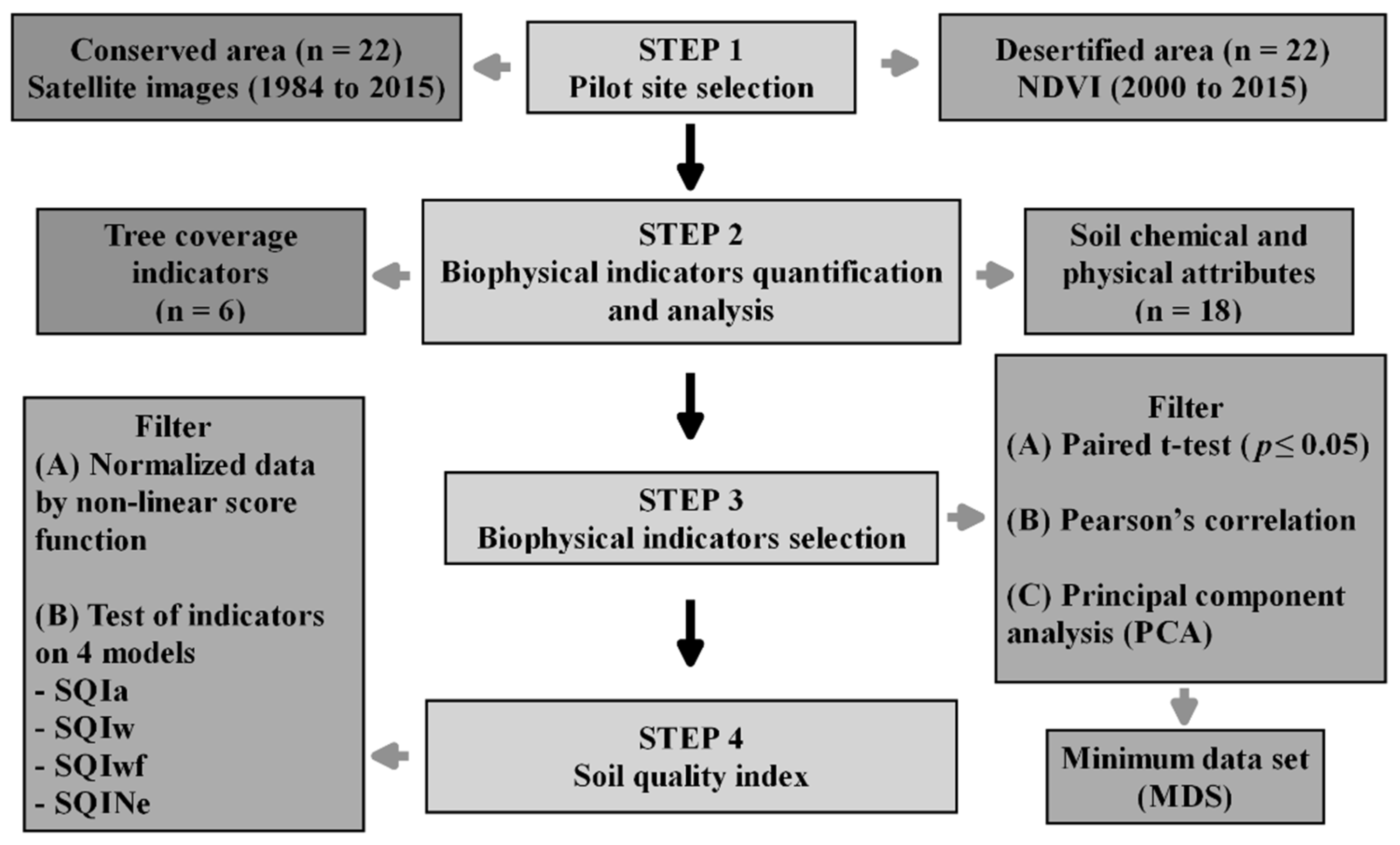

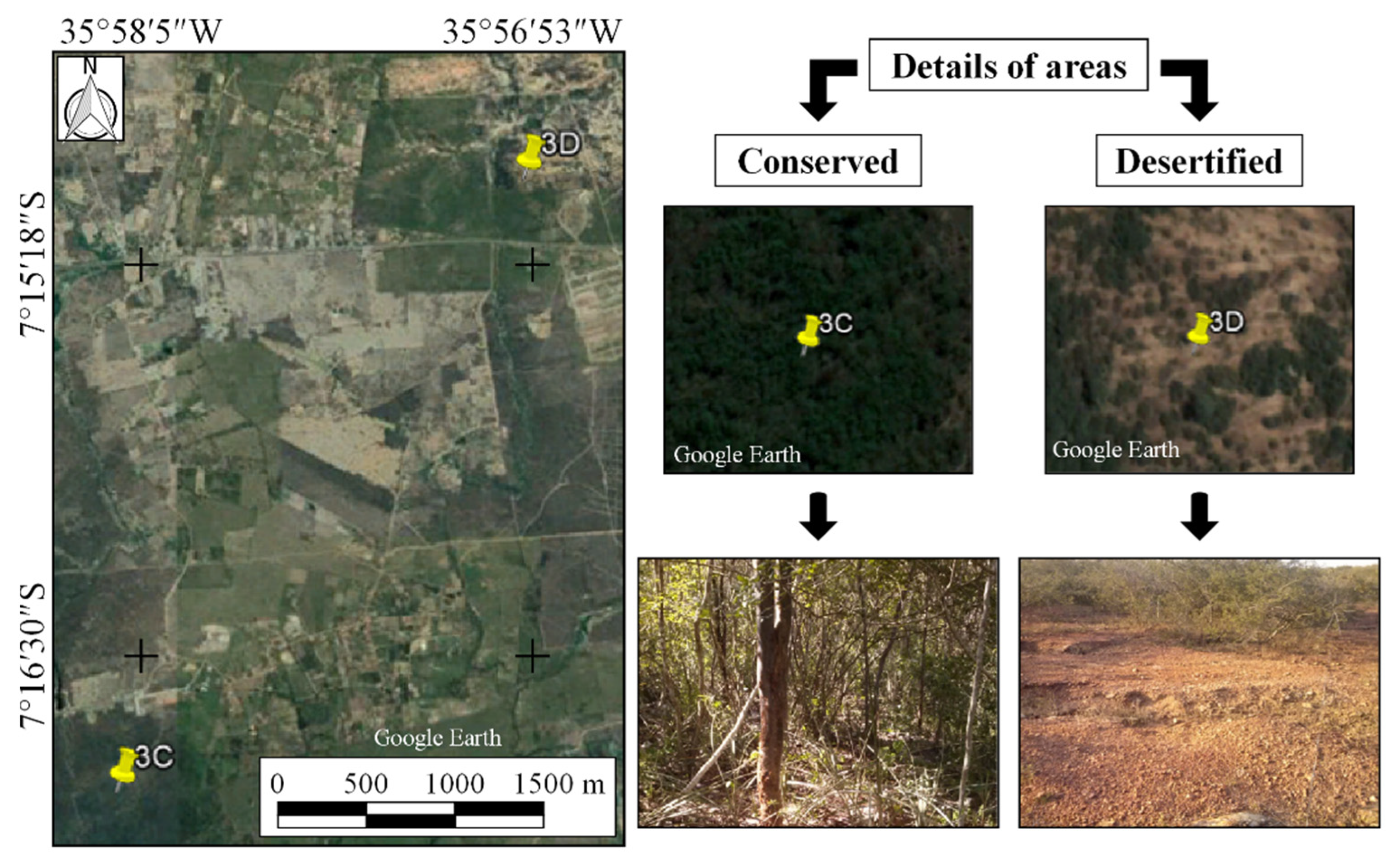




| Class | 1 SQI Scale | Conservation Level | DI Scale 2 | Degradation Level |
|---|---|---|---|---|
| I | >0.78 | Very high | <0.22 | Very Low |
| II | 0.62–0.78 | High | 0.22–0.38 | Low |
| III | 0.47–0.62 | Moderate | 0.38–0.53 | Moderate |
| IV | 0.31–0.47 | Low | 0.53–0.69 | High |
| V | <0.31 | Very low | >0.69 | Very High |
| Soil Chemical Indicators | Unit | Conditions of Pilot Sites | |
|---|---|---|---|
| Conserved (n = 22) | Degraded (n = 22) | ||
| Soil pH in water | logarithmic | 6.29 ± 0.14 a | 6.21 ± 0.15 a |
| Available P | mg kg−1 | 13.05 ± 0.24 a | 10.62 ± 0.25 b |
| Exchangeable K+ | mg kg−1 | 140.07 ± 0.21 a | 151.82 ± 14.79 a |
| Exchangeable Na+ | cmolc kg−1 | 0.06 ± 0.00 b | 0.16 ± 0.00 a |
| Exchangeable Ca2+ | cmolc kg−1 | 7.09 ± 0.60 a | 4.56 ± 0.31 b |
| Exchangeable Mg2+ | cmolc kg−1 | 2.26 ± 0.20 b | 2.90 ± 0.21 a |
| Potential acidity (H+Al) | cmolc kg−1 | 3.02 ± 0.34 a | 1.84 ± 0.3 b |
| Sum of bases (SB) | cmolc kg−1 | 9.65 ± 0.85 a | 7.94 ± 0.18 a |
| Effective Cation Exchange Capacity (CEC) | cmolc kg−1 | 9.67 ± 0.85 a | 8.28 ± 0.22 a |
| Cationic Exchange Capacity (potential CEC) | cmolc kg−1 | 12.67 ± 0.87 a | 10.06 ± 1.14 b |
| Total Organic Carbon (TOC) | g kg−1 | 28.06 ± 1.83 a | 3.13 ± 0.37 b |
| Base saturation (BS) | % | 75.32 ± 2.85 a | 78.55 ± 3.28 a |
| Exchangeable Sodium Percentage (ESP) | % | 0.59 ± 0.02 b | 1.81 ± 0.28 a |
| Soil physical indicators | |||
| Total Sand | g kg−1 | 620.29 ± 28.70 a | 642.36 ± 26.41 a |
| Silt | g kg−1 | 221.46 ± 18.95 a | 232.85 ± 17.80 a |
| Clay | g kg−1 | 158.22 ± 13.41 a | 124.75 ± 0.20 b |
| Bulk density (BD) | kg m−3 | 1.14 ± 0.03 b | 1.45 ± 0.03 a |
| Total porosity (TP) | % | 0.57 ± 0.01 a | 0.45 ± 0.01 b |
| Arboreal coverage indicators | |||
| No. species (Nsp) | Number | 9.82 ± 0.62 a | 1.94 ± 0.18 b |
| Plant density (PD) | Ind. ha−1 | 4818.18 ± 305.62 a | 872.51 ± 0.15 b |
| Total Absolute dominance (AD-T) | m2 ha−1 | 18.18 ± 0.27 a | 1.02 ± 0.1 b |
| Average canopy height (H-A) | M | 4.09 ± 0.15 a | 2.07 ± 0.16 b |
| Basal area (BA) | m2 ha−1 | 0.10 ± 0.01 a | 0.03 ± 0.00 b |
| Volume of biomass (VOL) | (m3 ha−1) | 2.00 ± 0.22 a | 0.49 ± 0.02 b |
| P | Na+ | Ca2+ | Mg2+ | H+Al | CEC | TOC | ESP | Clay | BD | PT | Nsp | PD | H-A | AD-T | BA | |
|---|---|---|---|---|---|---|---|---|---|---|---|---|---|---|---|---|
| Na+ | −0.73 *** | 1 | ||||||||||||||
| Ca2+ | 0.41 ** | −0.50 *** | 1 | |||||||||||||
| MgV | −0.21 | 0.32 * | −0.29 | 1 | ||||||||||||
| H+Al | 0.29 | −0.38 * | 0.14 | −0.05 | 1 | |||||||||||
| CEC | 0.06 | −0.27 | 0.45 ** | 0.08 | 0.27 | 1 | ||||||||||
| TOC | 0.72 *** | −0.90 *** | 0.63 *** | −0.35 * | 0.43 ** | 0.37 * | 1 | |||||||||
| ESP | −0.30 | 0.56 *** | −0.26 | 0.06 | −0.20 | −0.41 ** | −0.46 ** | 1 | ||||||||
| Clay | 0.19 | −0.36 * | 0.62 *** | −0.19 | 0.12 | 0.40 ** | 0.53 *** | −0.19 | 1 | |||||||
| BD | −0.66 *** | 0.78 *** | −0.34 * | 0.41 ** | −0.29 | −0.17 | −0.75 *** | 0.42 ** | −0.13 | 1 | ||||||
| PT | 0.66 *** | −0.78 *** | 0.34 * | −0.41 ** | 0.29 | 0.17 | 0.75 *** | −0.42 ** | 0.13 | −1 *** | 1 | |||||
| Nsp | 0.62 *** | −0.88 *** | 0.45 ** | −0.34 * | 0.28 | 0.30 | 0.76 *** | −0.53 *** | 0.27 | −0.74 *** | 0.74 *** | 1 | ||||
| PD | 0.62 *** | −0.89 *** | 0.38 * | −0.36 * | 0.20 | 0.14 | 0.74 *** | −0.51 *** | 0.38 * | −0.70 *** | 0.70 *** | 0.84 *** | 1 | |||
| H-A | 0.69 *** | −0.82 *** | 0.40 ** | −0.05 | 0.30 * | 0.32 * | 0.75 *** | −0.48 ** | 0.23 | −0.64 *** | 0.64 *** | 0.78 *** | 0.61 *** | 1 | ||
| AD-T | 0.73 *** | −0.99 *** | 0.49 *** | −0.31 * | 0.38 * | 0.26 | 0.89 *** | −0.56 *** | 0.33 * | −0.77 *** | 0.77 *** | 0.87 *** | 0.89 *** | 0.80 *** | 1 | |
| BA | 0.60 *** | −0.67 *** | 0.31 * | −0.12 | 0.22 | 0.18 | 0.61 *** | −0.36 * | 0.19 | −0.59 *** | 0.59 *** | 0.55 *** | 0.61 *** | 0.53 *** | 0.68 *** | 1 |
| VOL | 0.70 *** | −0.72 *** | 0.32 * | −0.21 | 0.41 ** | 0.19 | 0.64 *** | −0.40 ** | 0.17 | −0.66 *** | 0.66 *** | 0.57 *** | 0.66 *** | 0.61 *** | 0.72 *** | 0.65 *** |
| Biophysical Indicators | PC1 | PC2 | PC3 |
|---|---|---|---|
| Eigenvalues | 4.7846 | 1.5756 | 1.2125 |
| Percentage variance | 43.4965 | 14.3235 | 11.0232 |
| Cumulative percentage variance | 43.4965 | 57.8200 | 68.8432 |
| Eigenvectors | |||
| Available P | 0.7810 | −0.3440 | −0.0622 |
| Exchangeable Ca2+ | 0.6528 | 0.5117 | −0.2913 |
| Exchangeable Mg2+ | −0.3635 | 0.0958 | 0.7273 |
| Potential acidity (H+Al) | 0.4588 | −0.0337 | 0.3909 |
| Total Cation Exchange Capacity | 0.4287 | 0.6450 | 0.4096 |
| Total Organic Carbon | 0.9317 | 0.0636 | −0.0884 |
| Exchangeable Sodium Percentage | −0.5636 | −0.1077 | −0.3927 |
| Clay | 0.4829 | 0.6726 | −0.2617 |
| Bulk density | −0.8031 | 0.3353 | 0.0866 |
| Basal Area | 0.7255 | −0.2765 | 0.1273 |
| Volume of biomass | 0.7949 | −0.3351 | 0.1418 |
| Indicators of PC2 | Cation Exchange Capacity (CEC) | Clay |
|---|---|---|
| Cation Exchange Capacity (CEC) | 1.00 | 0.40 |
| Clay | 0.40 | 1.00 |
| Sum of correlations | 1.40 | 1.40 |
| Soil Indicator | Unit | Minimum | Maximum | Average | SD |
|---|---|---|---|---|---|
| Total Organic Carbon (TOC) | g kg−1 | 0.62 | 39.82 | 15.60 | 14.02 |
| Cation Exchange Capacity (CEC) | cmolc kg−1 | 2.89 | 23.16 | 11.37 | 4.88 |
| Clay | % | 4.00 | 24.00 | 14.00 | 5.00 |
| Mg2+ | cmolc kg−1 | 0.56 | 5.15 | 2.58 | 1.01 |
| MSD Indicators | COM 1 | Weight 2 | Factor Weight 3 |
|---|---|---|---|
| Exchangeable Mg2+ | 0.8693 | 0.2853 | 0.6318 |
| Cation Exchange Capacity (CEC) | 0.7661 | 0.2514 | 0.2081 |
| Total Organic Carbon (TOC) | 0.7377 | 0.2421 | 0.2081 |
| Clay | 0.6744 | 0.2213 | 0.1601 |
| Model for the Soil Quality Index (SQI) | Equations for the Calculation for the SQI |
|---|---|
| Weighted Additive [38,39] | SQIw = ∑(Score of Total Organic Carbon × 0.2421) + (Score of Cationic Exchange Capacity × 0.2514) + (Score of the percentage of clay × 0.2213) + (Score of Mg2+ × 0.2853) |
| Weighted Factorial Additive [24] | SQIwf = ∑(Score of Total Organic Carbon × 0.6318) + (Score of Cationic Exchange Capacity × 0.2081) + (Score of the percentage of clay × 0.2213) + (Score of Mg2+ × 0.1601) |
| Calculation Model of the Soil Quality Index | Regression Equation | R2 |
|---|---|---|
| Additive [42] | SQIa = 0.0085 × Total Organic Carbon + 0.3155 | 0.6120 |
| SQIa = 0.0223 × Total cation exchange capacity + 0.1950 | 0.5071 | |
| SQIa = 2.1639 × Percentage of clay + 0.1426 | 0.4428 | |
| SQIa = 0.0184 Mg exchangeable + 0.4012 * | 0.0146 | |
| Weighted Additive [58,59] | SQIW = 0.0080 × Total Organic Carbon + 0.3248 | 0.5622 |
| SQIW = 0.0219 × Total cation exchange capacity + 0.2001 | 0.5153 | |
| SQIW = 2.0013 × Percentage of clay + 0.1660 | 0.3994 | |
| SQIW = 0.0277 Mg exchangeable + 0.3776 * | 0.0349 | |
| Weighted Factorial Additive [45] | SQIWf = 0.0189 × Total Organic Carbon + 0.22236 | 0.9089 |
| SQIWf = 0.0297 × Total cation exchange capacity + 0.1811 | 0.2718 | |
| SQIWf = 3.5214 × Percentage of clay + 0.0207 | 0.3436 | |
| SQIWf = −0.0490 × Mg exchangeable + 0.6455 | 0.0313 | |
| Nemoro [51] | SQINe = 0.0059 × Total Organic Carbon + 0.1695 | 0.5842 |
| SQINe = 0.0136 × Total cation exchange capacity + 0.1071 | 0.3772 | |
| SQINe = 1.4844 × Percentage of clay + 0.0512 | 0.4204 | |
| SQINe = 0.0138 Mg exchangeable + 0.2256 * | 0.0165 |
| TOC | SQIa | SQIw | SQIwf | SQINe | |
|---|---|---|---|---|---|
| TOC | 1 | ||||
| SQIa | 0.78 *** | 1 | |||
| SQIw | 0.75 *** | 1 *** | 1 | ||
| SQIwf | 0.95 *** | 0.92 *** | 0.90 *** | 1 | |
| SQINe | 0.76 *** | 0.97 *** | 0.97 *** | 0.91 *** | 1 |
Publisher’s Note: MDPI stays neutral with regard to jurisdictional claims in published maps and institutional affiliations. |
© 2022 by the authors. Licensee MDPI, Basel, Switzerland. This article is an open access article distributed under the terms and conditions of the Creative Commons Attribution (CC BY) license (https://creativecommons.org/licenses/by/4.0/).
Share and Cite
Perez-Marin, A.M.; Vendruscolo, J.; Zárate-Salazar, J.R.; De Araújo Queiroz, H.A.; Magalhães, D.L.; Menezes, R.S.C.; Fernandes, I.M. Monitoring Desertification Using a Small Set of Biophysical Indicators in the Brazilian Semiarid Region. Sustainability 2022, 14, 9735. https://doi.org/10.3390/su14159735
Perez-Marin AM, Vendruscolo J, Zárate-Salazar JR, De Araújo Queiroz HA, Magalhães DL, Menezes RSC, Fernandes IM. Monitoring Desertification Using a Small Set of Biophysical Indicators in the Brazilian Semiarid Region. Sustainability. 2022; 14(15):9735. https://doi.org/10.3390/su14159735
Chicago/Turabian StylePerez-Marin, Aldrin Martin, Jhony Vendruscolo, Jhonatan Rafael Zárate-Salazar, Heithor Alexandre De Araújo Queiroz, Daniel Lima Magalhães, Rômulo S. C. Menezes, and Izaias Médice Fernandes. 2022. "Monitoring Desertification Using a Small Set of Biophysical Indicators in the Brazilian Semiarid Region" Sustainability 14, no. 15: 9735. https://doi.org/10.3390/su14159735
APA StylePerez-Marin, A. M., Vendruscolo, J., Zárate-Salazar, J. R., De Araújo Queiroz, H. A., Magalhães, D. L., Menezes, R. S. C., & Fernandes, I. M. (2022). Monitoring Desertification Using a Small Set of Biophysical Indicators in the Brazilian Semiarid Region. Sustainability, 14(15), 9735. https://doi.org/10.3390/su14159735






